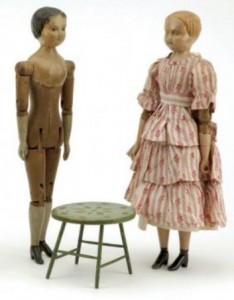by Mike Wilcox (09/20/10). |

Ellis dolls, with heads of steamed and pressure molded maple and bodies of turned maple, used a patented joint system, each joint using a friction fit split mortise and tenon.
Identification of dolls can be difficult, hindered by the fact many are unmarked, some manufacturers made parts for other doll makers and the market has generated a lot of reproductions. What can help though is learning some characteristics that are almost unique to certain makers, such as in the case of the dolls created by the Co-operative Manufacturing Company of Springfield, Vt.
The company was founded by Joel Addison Hartley Ellis (1858-1925) in the early 1870s. Ellis’ operation started out in1856 as a woodworking shop for the manufacture of doll carriages, baby carriages, sleds, carts and wagons.
Ellis dolls, which were made circa 1871-1873, had features that are almost unique: the heads, unlike most of the period are not china or wax, but end grain maple, steamed and pressure molded; the feet and hands were cast metal; even the bodies differed most Victorian dolls, in that they were turned maple and not stuffed kid or composition.
Another feature that differed from most Victorian dolls is that the Ellis dolls used a patented joint system, each joint using a friction fit split mortise and tenon. This system allowed the doll to be posed in any number of positions.
Ellis dolls came in 12-, 15- and 18-inch sizes, but based on surviving examples, the 12″ size must have been the biggest seller. The Ellis dolls are very collectible and, if in good condition, rarely sell at auction for less than $300.

No comments:
Post a Comment